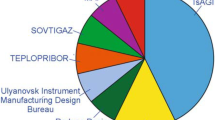Abstract
Anemometric method is the most accurate and reliable technique for air velocity measurement. In present work, a voltage follower based circuit is proposed, and a low-cost sensor (tungsten filament) is chosen to perform Constant Voltage Anemometer (CVA) operation for air velocity measurement. For performing the real-time experiment, a wind tunnel featuring a rectangular section (test section I) and a circular section (test section II) with a provision for low-cost sensors and a reference Hot Wire Anemometer (HWA) was fabricated. The measurement is repeated multiple times for various air velocities in the range of 3 m/s to 12 m/s. The estimated ‘pdr’ value (ratio of the power dissipated in the sensor, Pw to the difference between heated sensor resistance, Rw and the sensor resistance at ambient temperature, Ra), considered as new output voltage, is analogous with the output voltage (Vo) of the proposed circuit. The range of ‘pdr’ in test sections I and II is 0.033 mW/Ω to 0.867 mW/Ω and 0.0062 mW/ῼ to 0.1059 mW/Ω, respectively. Similarly, overheat ratio, OHR (ratio of the difference between heated sensor resistance, Rw and the sensor resistance at ambient temperature, Ra to the sensor resistance at ambient temperature, Ra) estimated, is also found to be analogous with the change in temperature (difference between the temperature of the heated sensor Tw and the ambient temperature Ta). The range of OHR in test sections I and II is 0.709 to 0.660 and 0.678 to 0.647, respectively. Uncertainty analysis is carried out for the proposed voltage follower based CVA measurement system and the expanded uncertainty with a 95% confidence level is obtained as 0.54 for the whole range of air velocity measurement.











Similar content being viewed by others
References
Brunn H (1995) Hot-wire anemometry, principles and signal analysis. New York, Oxford University Press
PGSA (2011) Bandara. University of Peradeniya, Constant Current Hot-wire Anemometer. Ph.D.thesis
Nandita Sanyal A, Biswajit Bhattacharyya B, Sugata Munshi B (2006) An analog non-linear signal conditioning circuit for constant temperature anemometer. Measurement. 39:308–311. https://doi.org/10.1016/j.measurement.2005.11.020
Ardekani MA, Farhani F (2010) Practical considerations for validity of constant temperature anemometer flow measurements in industrial applications. Flow Meas Instrum 21:123–127. https://doi.org/10.1016/j.flowmeasinst.2010.01.007
S.Mangalam, G.R.Sarma, S.Kuppa, L.Kubendran, A new approach to high speed flow measurements using constant voltage anemometry, Presented in 28th Joint propulsion conference, In: AIAA 92–3957, https://doi.org/10.2514/6.1992-3957
G.R.Sarma, Analysis of constant voltage anemometer circuit. Presented in IEEE Instrumentation and Measurement technology conference,1993,731–736, https://doi.org/10.1109/imtc.1993.382547
Sarma GR (1998) Transfer function analysis of the constant voltage anemometer. Rev Sci Instrum 69:2385–2391. https://doi.org/10.1063/1.1148964
G Comte Bellot, G.R.Sarma, T.Faure, J.P.Dussauge, P.Dupant, J.F.Debieve Performance studies of constant voltage anemometer in a Mach 2.3 Boundary layer, IEEE, Presented in 18th International Congress on Instrumentation in Aerospace Simulation Facilities, Toulouse, France, June 14–17,1999. https://doi.org/10.1109//iciasf.1999.827180
Weiss J, Comte-Bellot G (2004) Electronic noise in a constant voltage anemometer. Rev Sci Instrum 75:1290–1296. https://doi.org/10.1063/1.1711147
Kegerise MA, Spina EF (2000) A comparative study of constant voltage and constant temperature hot wire anemometers: Part II: the dynamic response Experiments in Fluids. Experiments in fluids 29:165–177. https://doi.org/10.1007/s003489900074
Berson A, Blanc-Benon P, Comte-Bellot G (2009) A strategy to eliminate all nonlinear effects in constant voltage hot-wire anemometry. Rev Sci Instrum 80(4):045102. https://doi.org/10.1063/1.3103948
Sarma GR, Comte-Bellot G (2002) Automated constant voltage anemometer for measurements with fluid temperature drifts. Rev Sci Instrum 73:1313–1317. https://doi.org/10.1063/1.1447303
Guido E, Truzzi G, Sarma R, Chokani N (2002) Constant voltage anemometer operated hot-wire at subsonic speeds over wide overheats in unsteady flows. Review of scientific instruments 73:4363–4368. https://doi.org/10.1063/1.1516850
Berson A, Poignand G, Blanc Benon P, Comte-Bellot G (2010) Capture of instantaneous temperature in oscillating flows: use of constant voltage anemometry to correct the thermal lag of cold wires operated by constant-current anemometry, 015102. Review of Scientific Instruments:81. https://doi.org/10.1063/1.3274155
Weiss J, Chokani N, Comte-Bellot G (2005) Constant temperature and constant voltage anemometer use in a mach 2.5 flow. American Institute of Aeronautics and Astronautics (AIAA) Journal 43/5:1140–1143. https://doi.org/10.2514/1.6411
Sadeghi A (2014) Investigation of the frequency response of constant voltage anemometers in turbulent flows. Master’s thesis, Ecole Polytechnique de Montreal
Mohammed-Taifour A, Weiss J, Sadeghi A, Jerome V, Jondeau E, Comte-Bellot G (2015) A detailed procedure for measuring turbulent velocity fluctuations using constant voltage anemometry. Experiments in Fluids 56:174. https://doi.org/10.1007/s00348-015-2045-0
Tao systems. www.taosystem.com / products (accessed 17 December 2016)
Mahesh K Panda and Amiya K. Samanta (August 2016) Design of low cost open circuit wind tunnel – a case study. Indian Journal of Science and Technology 2016, Vol 9(30). https://doi.org/10.17485/ijst/2016/v9i30/99195
Giancoli, C.Douglas, physics- principles with applications 4th Ed, Prentice Hall, 1995
More BS, Dutta S, Chauhan MK, Gandhi BK (2015) Experimental investigation of flow field behind two tandem square cylinders with oscillating upstream cylinder. Experimental Thermal and Fluid Science 68:339–358
Ozahi E, Ozdinc M, Carpinlioglu M, Gundogolu Y (2010) Simple methods for low speed calibration of hot wire anemometers. Flow Measurement and Instrumentation 21:166–170. https://doi.org/10.1016/j.flowmeasinst.2010.02.004
User’s manual –AMPROBE TM 21HW Hot wire anemometer
Dwyer Instruments www.dwyer-inst.com/ product/ Test Equipment/ Thermo Anemometers/ Accessed 4 Feb 2018
Abdullah, M Al-Garni. (2007) Low speed calibration of hotwire anemometers. Flow Measurement and Instrumentation. 18, 95–98. https://doi.org/10.1016/j.flowmeasinst.2007.01.003
Sarma GR, Comte-Bellot G (1999) Automated CVA with in situ measurements of overheat and time constant of hot wire. Review of scientific instruments 70:2384–2386. https://doi.org/10.1063/1.1149790
Ivo Leito., Lauri Jalukse.,Irja Helm.: University of Tartu, Online Course ‘Estimation of Measurement uncertainty in chemical analysis’. (accessed 4 Sept 2018)
JCGM 100:2008 (GUM 1995 with minor corrections), Evaluation of measurement data guide to the expression of uncertainty in measurement (accessed 4 Sept 2018)
Author information
Authors and Affiliations
Corresponding author
Ethics declarations
Conflict of Interest
On behalf of all authors, the corresponding author states that there is no conflict of interest.
Additional information
Publisher’s Note
Springer Nature remains neutral with regard to jurisdictional claims in published maps and institutional affiliations.
Rights and permissions
About this article
Cite this article
Sivakami, V., Pal, A. & Vasuki, B. Realization of Constant Voltage Anemometer Using an Alternative Signal Conditioning Circuit. Exp Tech 44, 613–623 (2020). https://doi.org/10.1007/s40799-020-00379-4
Received:
Accepted:
Published:
Issue Date:
DOI: https://doi.org/10.1007/s40799-020-00379-4




